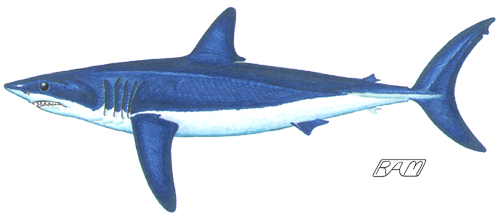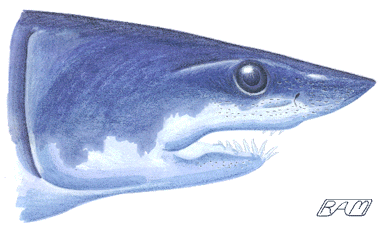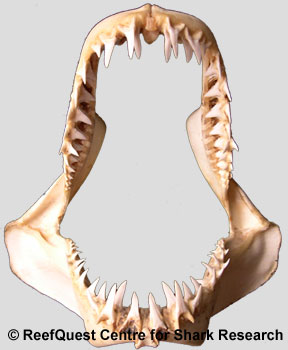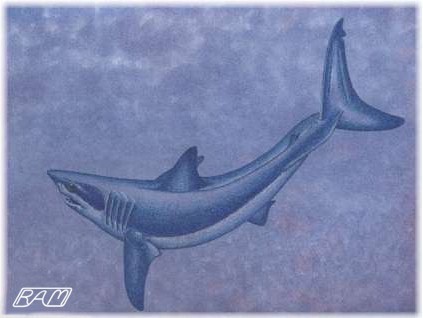Biology of the Shortfin Mako
(Isurus oxyrinchus)

| Field Marks | Body slender, spindle-shaped; snout conical, moderately long and acutely pointed; teeth smooth-edged, without basal cusplets, tips of anterior teeth strongly reflexed; gill slits long, extending partially onto top of head; pectoral fins rather narrow-tipped and less than 70% of head length; first dorsal fin origin behind free rear tip of pectorals; second dorsal and anal fins minute, with pivoting base; strong keels on caudal peduncle; caudal fin lunate. Color: metallic indigo to bluish black above, fading to ultramarine on the flanks; white below, including undersurface of snout and area around the mouth; a race occurring off the Azores has extensive dusky blotching on the underside of the snout, around the mouth, and on the belly, resembling the pigmentation pattern — but not the morphology — of the Longfin Mako (Isurus paucus). |
| Size | Pups are 24-29.5 in (60-75 cm) long at birth; most individuals encountered are 6-8 ft (1.8-2.5 m) long and 135-300 lb (60-135 kg) in weight; maximum known length is (3.9 m), based on a 500-lb (227-kg) female specimen from the Indian Ocean, but exceptional individuals have been reported to weigh up to 1 250 lb (570 kg). |
| Range | Cosmopolitan in tropical and temperate seas; a recent confirmed record from off British Columbia, Canada. |
| Habitat | Common in coastal and oceanic regions of tropical and warm temperate seas, but seldom occurring in waters less than 61°F (16°C); preferred temperature range in western North Atlantic 63-72°F (17-22°C); known depth range from the surface down to at least 1,300 ft (400 m). General daily and seasonal activity patterns of this species not well known; tends to follow movements of warm water in the extreme northern and southern parts of its range; tagging studies off the northeastern US show a seasonal pattern of abundance along western margin of the Gulf Stream, moving inshore and into higher latitude waters as the Stream shifts northward from April-October, possibly wintering in the Sargasso Sea from November-March. Individuals tagged off the US east coast are rarely reported from off Europe (in 28 years of NMFS tagging, a single tag was recovered from a specimen caught off the coast of Spain, a straight-line distance of some 2,820 mi or 4,540 km), suggesting limited population exchange between the eastern and western North Atlantic (this population appears to be centered between Latitudes 20 and 40°N, bounded by the Mid-Atlantic Ridge on the east and the Gulf Stream on the west); this interpretation is supported by genetic sampling from both sides of this ocean basin. In December 1998, a female specimen originally tagged off California was recaptured by a Japanese research vessel in the central Pacific, having traveled over 1,725 mi (2,780 km); it is only the second individual of this species to be recaptured from this region. Tagging studies conducted off the east coast of New Zealand reveal recaptures at or very close to original tagging sites that peak annually, indicating seasonal migrations; where these makos go for the rest of the year is unclear, although at least one individual tagged in New Zealand was recaptured north-west of Fiji. Apparently segregates by sex, at least in some parts of its range; 71% of catches in mesh nets off New South Wales, Australia, were male, taken in spring and early summer (August-January), while in mesh nets off Natal, South Africa, only females were taken offshore while males were only taken inshore; South African catches consisted of 1.4 males/female, most being taken May-November, when the water tends to be cooler than at other times of the year. Juveniles tracked in the Southern California Bight spent 90% of their time in the 68-70°F (20-21°C) mixed-water layer just above the thermocline (which occurred at a depth of 45-65 ft or 14-20 m); conversely, a large adult female tracked traveling from Cape Canaveral, Florida, to the Bahamas spent most of its time well below the mixed layer, reaching depths greater than 1 300 ft (400 m) on several occasions. A strong-swimming, active species capable of mild endothermy, maintaining body temperatures 12.5-18°F (7-10°C) warmer than the ambient water; juveniles tracked in the Southern California Bight cruised at an average rate of 0.8-1.7 mph (1.3-2.8 km/hr), while a large female tracked off eastern Florida averaged 1.6 mph (2.5 km/hr). Capable of rapid acceleration and astonishing bursts of speed when hooked or in pursuit of prey: a 3-ft (1-m) juvenile filmed chasing a bait trolled off Auckland, New Zealand, reportedly accelerated from a dead stop to cover the more than 100 ft (30 m) distance to the bait in just 2 seconds — assuming a constant rate of acceleration, calculations suggest it reached a top speed of about 68 mph (110 km/hr). Adults have been reliably clocked at 31 mph (50 km/hr); there are claims that they can achieve a burst swimming speed of up to 46 mph (74 km/hr). Known to leap completely out of the water — often repeatedly, especially when hooked (a quality that contributes to its reputation as a paramount game fish) — able to clear the surface by several times its body length (some reports claim leaps of 20 ft [6 m] or more). |
| Feeding | Preys primarily on other fishes, including: mackerels, tunas, bonitos and other scombrids; anchovies and herrings; grunts; lancetfishes; cod, ling, whiting and other gadids; Australian salmon (Arripis spp.); yellowtails and other carangids; sea basses; porgies; Swordfish; and other sharks, such as the Blue (Prionace glauca), whalers (Carcharhinus spp.), and hammerheads (Sphyrna spp.); other stomach contents have included sea turtle heads, a 'porpoise' (probably a pelagic dolphin, family Delphinidae), squids, salps, and occasionally detritus. Regional variation in diet probably reflects differences in prey type and availability: in a study off Sydney, Australia, 86% of prey consisted of teleosts (especially jacks and alfonsos) and 22% of cephalopods; in a similar study off Natal, South Africa, elasmobranchs were the most common prey category, occurring in 60% of stomachs examined, followed by teleosts, occurring in 40% of stomachs; off the northeast coast of the US, 67% of stomachs examined (78% by volume) contained Bluefish (Pomatomus saltatrix), composing the major food item in inshore waters of the western North Atlantic. Surprisingly, marine mammals are rarely reported in the diet of this species, but may be expected particularly in large individuals; specimens over 10 ft (3 m) long have very broadly triangular, flattened upper teeth, perhaps more suitable for dismembering large prey than the awl-shaped teeth of smaller individuals. In western North Atlantic, daily ration for an average-sized (139-lb or 63-kg) individual has been estimated to be at least 4.5 lbs (2 kg) — about 3% of total body weight per day or 10 times its weight each year; stomach capacity about 10% of total body weight, an average-sized meal requiring about 1.5-2.0 days to digest; during periods of particularly high metabolic demand (early growth, prey capture, migration), food ration may increase 1.2-1.5 times. Forms temporary loose aggregations in areas offering particularly rich feeding. |
| Reproduction | Ovoviviparous, featuring oophagy at later stages of development; litter size 4-25, with larger females giving birth to more and larger pups; born during spring in both hemispheres (May-June in the western North Atlantic; November off New South Wales, Australia) after a gestation period of 15-19 months (indicating a reproductive cycle of 2-3 yrs); nursery areas not well known, but may include the Southern California Bight. Mating probably takes place during late summer-fall; from seasonal appearance of scars on females, mating behavior apparently features males ritualistically biting females on the belly, flanks, pectoral fins, and gill region. |
| Age & Growth | In the Western North Atlantic, males reach sexual maturity at about 6.4 ft (1.95 m) in length, 140 lb (55.5 kg) in weight and an age of about 2 yrs, while females reach maturity at 9.25-9.7 ft (2.8-2.96 m) in length, 440-525 lb (200-240 kg) in weight, and an age of about 6 yrs; females from the Southern Hemisphere reach maturity at a smaller size than those from the western North Atlantic, 50% becoming mature at a length of about 8.9 ft (2.72 m) and a weight of about 400 lb (180 kg). Longevity of females has been estimated at 25 yrs. |
| Danger to Humans | Attacks on divers and swimmers by this species are relatively rare and few are reliably reported, but those that have occurred suggest that it should definitely be regarded as dangerous; in the SAF, a total of 38 attacks are attributed to this species (12 unprovoked, 10 provoked, 15 boat attacks, and 1 unassigned). Its speed, power, and large raptorial teeth invite respect. The offshore habitat of this species probably prevents it from coming into contact with many swimmers, but attacks on swimmers are known to have occurred (in the northern Red Sea, a young woman was savagely bitten 12 times by what later proved to be a Shortfin Mako); often inquisitive and unafraid of divers, often approaching directly and closely, can become highly aggressive when feeding stimuli (such as speared fish) are present; tends to respond aggressively when hooked or harassed, and should not be speared or otherwise provoked underwater. Numerous attacks by this species on boats have been reported, second only to those perpetrated by the White Shark (Carcharodon carcharias); the sport angling literature is rife with vivid accounts of these sharks biting, leaping into, and even smashing through the boats of their assailants — anglers who have suddenly found themselves sharing a boat with an aroused, thrashing mako have been known to leap into the water. |
| Utilization | An important species for longline fisheries where it occurs, because of its high-quality meat; considerable fisheries occur in the Mediterranean (landed in Italy), off West Africa and Cuba, in the Gulf of Mexico and Caribbean, off southern California, and in the western and central Pacific; the meat is utilized fresh, frozen, smoked and dried salted for human consumption; the liver oil is extracted for vitamins, the fins are used for shark-fin soup, the hides processed into leather, the jaws and teeth sold as curios and ornaments; caught in gillnets as well as on pelagic longlines and hook-and-line. Highly regarded as a sport fish, famed for its powerful, torpedo-like runs and spectacular leaps; IGFA All-Tackle record is 1,115 lb (506 kg), caught off Black River, Mauritius in November 1988. |
| Remarks | The Peregrine Falcon of the shark world, the Shortfin Mako may be the fastest shark and one of the swiftest and most active of fishes; for a shark of such commercial importance and great fame — particularly among sport anglers — knowledge of its biology is surprisingly sketchy. |
Just about every shark enthusiast has one species that is his or her absolute, hands-down favorite. Some favor the Great White. Others hold in particularly high regard the strange and wonderful hammerheads, Goblin, or thresher sharks. Still others — divers mostly — regard as deeply totemic whichever shark species they first encountered in the wild. The precise combination of favorite shark species and the reasons for choosing it are as many and varied as shark enthusiasts themselves. For what its worth, the Shortfin Mako is my all-time favorite shark.
Growing to a length of almost 13 feet (4 metres) and a weight of over 1,100 pounds (500 kilograms), the Shortfin Mako is, by any standard, an impressive fish. For me, however, there is something more. This species seems to exhibit the very finest attributes (real or projected by my admittedly romantic imagination) ever evolved by sharkdom. A symphony of liquid grace and finely controlled power, the Shortfin Mako is warm-bodied, free to roam the depths and breadths of the open ocean in a way that evokes admiration and envy in my wanderlust heart. From stem to stern, the Shortfin Mako is an exquisitely streamlined, beautifully sculpted fish; inside and out, this species' form and function is spare and efficient, enabling it to utilize energy with elegant economy yet sprint as fast as the fastest fish in the sea. Its large, dark eyes suggest a degree of intelligence and sensitivity that it may not, in fact, possess. And — if I am to be completely honest — I must confess that there is another, psychologically revealing reason behind my fascination for this particular shark: it seems the quintessential embodiment of predatory lethality.
The Shortfin Mako is the fastest lamnid and the champion speedster among sharks. It is also a spectacular and much sought-after gamefish, often leaping repeatedly when hooked. Among sport anglers, this explosive activity combined with dazzling ultramarine flanks has earned the Shortfin Mako the dramatic honorific, "Blue Dynamite". Famed western author and big game angler Zane Grey held this species in particularly high regard, noting that hooked Shortfins typically leap in sets of three, with the third leap usually the highest — sometimes as much as 15 to 20 feet (5 to 6 metres) above the surface. Calculations show that for a mako to leap 20 feet (6 metres) into the air, a speed of 24.6 miles (39.6 kilometres) per hour is required — and this for a shark impeded by the drag of a fishing line trailing from its mouth.
 Underwater
and unimpeded by a fishing line, the Shortfin Mako has been reliably clocked at
31 miles (50 kilometres) per hour, and there is one claim that this species is
capable of a burst speed of up to 46 miles (74 kilometres) per hour. But it is
extremely difficult to get a fish in the wild to swim in a straight line over a
measured course. Laboratory measurements of numerous kinds of fishes —
representing a wide range of body sizes — swimming against an artificial current
have revealed a surprisingly uniform maximum burst speed of about 10 times the
body length per second. Thus, for an average-sized, 6.5-foot (2-metre) Shortfin,
its theoretical maximum speed might be something on the order of 45 miles (72
kilometres) per hour. Some estimates of the top-speed of a Shortfin Mako are
considerably higher.
Underwater
and unimpeded by a fishing line, the Shortfin Mako has been reliably clocked at
31 miles (50 kilometres) per hour, and there is one claim that this species is
capable of a burst speed of up to 46 miles (74 kilometres) per hour. But it is
extremely difficult to get a fish in the wild to swim in a straight line over a
measured course. Laboratory measurements of numerous kinds of fishes —
representing a wide range of body sizes — swimming against an artificial current
have revealed a surprisingly uniform maximum burst speed of about 10 times the
body length per second. Thus, for an average-sized, 6.5-foot (2-metre) Shortfin,
its theoretical maximum speed might be something on the order of 45 miles (72
kilometres) per hour. Some estimates of the top-speed of a Shortfin Mako are
considerably higher.
In an effort to determine the maximum swimming speed of the Shortfin Mako, two New Zealand researchers undertook a simple experiment which yielded astonishing results. Off the coast of Auckland, aquarist Craig Thorburn and film-maker Mike Bhana videotaped a 3-foot (1-metre) juvenile Shortfin Mako — estimated to be about one year of age — chasing a baited camera trolled behind their boat. The shark seemed to have no trouble keeping up with the towed array at medium speeds, so the researchers decided to accelerate to see just how fast the little Mako could go. From this experiment, Thorburn and Bhana estimate that the shark accelerated from a dead stop to cover a distance to the bait of more than 100 feet (30 metres) in just two seconds. If, as Thorburn and Bhana attest, the shark did indeed start from a standstill — which seems behaviorally unlikely — to cover the stated distance in the stated time, the little Mako must have achieved an acceleration of at least 50 feet (15.24 metres) per second, per second. This acceleration rate rivals that of the very fastest sport cars and seems rather improbable. Nevertheless, using this figure as the constant rate of acceleration, calculations suggest that by the time this little Mako reached caught up with the bait, it reached a top speed of about 68 miles (110 kilometres) per hour! But it should be stressed that if any of Thorburn and Bhana's estimates (the shark's initial speed, the actual distance covered, the time required to reach the bait, etc.) is inaccurate, this startling figure could be 'off' by quite a bit.
 Whatever its actual top speed, there is little doubt that the Shortfin Mako
is able to catch and eat very speedy prey. It is primarily a piscivore, taking
mackerels, tunas, bonitos and other scombrids, anchovies, herrings, Bluefish (Pomatomus
saltatrix), grunts, lancetfishes, cod, ling, whiting and other gadids,
Australian 'salmon' (Arripis), yellowtails and other carangids, sea
basses, porgies, Swordfish (Xiphias gladius), and even other sharks
(including Blue Sharks [Prionace glauca], whaler sharks [Carcharhinus],
and hammerheads [Sphyrna]). Many of these fishes are particularly
fast-swimming, yet they are apparently snapped-up 'on the fin': fishes taken
from the stomachs of Shortfin Makos that are not in an advanced stage of
digestion are often surprisingly 'healthy-looking' — except for the deep stab
wounds mid-body, where the shark apparently grasped each fish once before
swallowing it whole.
Whatever its actual top speed, there is little doubt that the Shortfin Mako
is able to catch and eat very speedy prey. It is primarily a piscivore, taking
mackerels, tunas, bonitos and other scombrids, anchovies, herrings, Bluefish (Pomatomus
saltatrix), grunts, lancetfishes, cod, ling, whiting and other gadids,
Australian 'salmon' (Arripis), yellowtails and other carangids, sea
basses, porgies, Swordfish (Xiphias gladius), and even other sharks
(including Blue Sharks [Prionace glauca], whaler sharks [Carcharhinus],
and hammerheads [Sphyrna]). Many of these fishes are particularly
fast-swimming, yet they are apparently snapped-up 'on the fin': fishes taken
from the stomachs of Shortfin Makos that are not in an advanced stage of
digestion are often surprisingly 'healthy-looking' — except for the deep stab
wounds mid-body, where the shark apparently grasped each fish once before
swallowing it whole.
A 1982 study by fisheries biologists Chuck Stillwell and Nancy Kohler examined the diet and feeding habits of the Shortfin Makos in the western North Atlantic. Stillwell and Kohler examined the stomach contents of 399 Shortfin Makos of both sexes, ranging in length from 2.2 to 10.8 feet (0.7 to 3.3 metres). Samples were obtained from specimens landed during shark fishing tournaments held in New Jersey, New York, and Rhode Island, and others from individuals taken as bycatch on offshore longlines set between Cape Hatteras, North Carolina, and the Grand Banks. Teleost remains were found in 67% of the stomachs examined, while cephalopods were found in 15% of stomachs. Cephalopods consumed by the Shortfin Mako were primarily ommastrephiid squids — especially the Short-Finned Squid (Illex illecebrosus), a species which is abundant throughout the study area from spring through fall — and were taken mostly in offshore waters.
Perhaps the most startling revelation of Stillwell and Kohler's study is the enormous importance of Bluefish in the diet of the Shortfin Mako off the US Atlantic seaboard. Bluefish occurred in 43.8% of Shortfin Mako stomachs examined and, by volume, constituted 77.5% of this species' diet; consumption and diet were found to be the same for both sexes. Stillwell and Kohler found that the average stomach capacity of a Shortfin Mako is about 10% of its body weight and estimated the average daily ration at about 4.5 pounds (2 kilograms). From this, Stillwell and Kohler calculated that, each year, Shortfin Makos may consume 4.3 to 14.5% of the available Bluefish resource in the area between Cape Hatteras and Georges Bank.

Stomach contents of Shortfin Makos have also been reported to included sea turtle heads, a 'porpoise' (probably a pelagic dolphin, family Delphinidae), squids, salps, and — occasionally — detritus. Surprisingly, pelagic dolphins are rarely reported in the diet of the Shortfin Mako, but have been found among the stomach contents of very large individuals. The Shortfin Mako's teeth are highly distinctive: smooth-edged and — at the front of the jaw, at least — gracefully recurved: the efficient grasping teeth of a fish-eater. But, like those of the White Shark (Carcharodon carcharias), the upper anterior teeth of the Shortfin Mako broaden with increasing size. Shortfins over 10 feet (3 metres) long have relatively broad, flat, and triangular upper anteriors, which are perhaps more suitable for dismembering large prey than the awl-shaped upper teeth of smaller Makos. Thus, unlike smaller Shortfin Makos, large individuals may be able to feed on prey too big to be swallowed whole.
Fortunately for us, in the vast majority of cases shark attack do not seem to be feeding related. Yet — because of its large size, awesome speed, power, and dentition, and aggressive nature — the Shortfin Mako is definitely a dangerous shark. Although authenticated reports of attacks by this species against humans are very rare, it has been known to attack divers and even the occasional swimmer. I have dived with solitary subadult Shortfin Makos on several occasions, and they still unnerve me . . . perhaps even more than the much larger but slower and more 'controlled' White Shark. In baited contexts, at least, I have found that a Shortfin generally moves and changes direction relatively quickly, buzzing past a diver only to circle and repeat the twitchy, high-speed visual inspection. In short, a Shortfin Mako often seems a bundle of pent-up nervous energy. This species' combination of rapid, jittery movements and a mouth bristling with wicked-looking teeth always reminds me of an archetypal neophyte armed robber: jangling nerves and a lethal weapon with a hair-trigger — potentially a very explosive situation! Fortunately, the generally offshore habitat of the Shortfin Mako prevents it from coming into contact with most swimmers. Most, but not all.
At about 5 p.m. on 7 September 1974 at the northeastern extreme of the Red Sea, a 20-year-old woman — identified in the technical report only as "Ms. B.A." — was swimming with her boyfriend about 1,650 feet (500 metres) offshore when she was savagely and repeatedly attacked by a 6-foot (2-metre) shark, later positively identified as a Shortfin Mako. Before being rescued, B.A. was bitten approximately 12 times, mostly on her forearms and thighs. She barely survived the attack; ultimately, her lower left arm had to be amputated.
It is quite possible, perhaps likely, that the Shortfin Mako would be something less than my favorite shark if one mangled me in the same manner as the unfortunate Ms. B.A. If I am ever attacked by a Shortfin Mako, it would remain a fast, beautiful, and superbly efficient creature. But some forms of appreciation are best at a distance.
